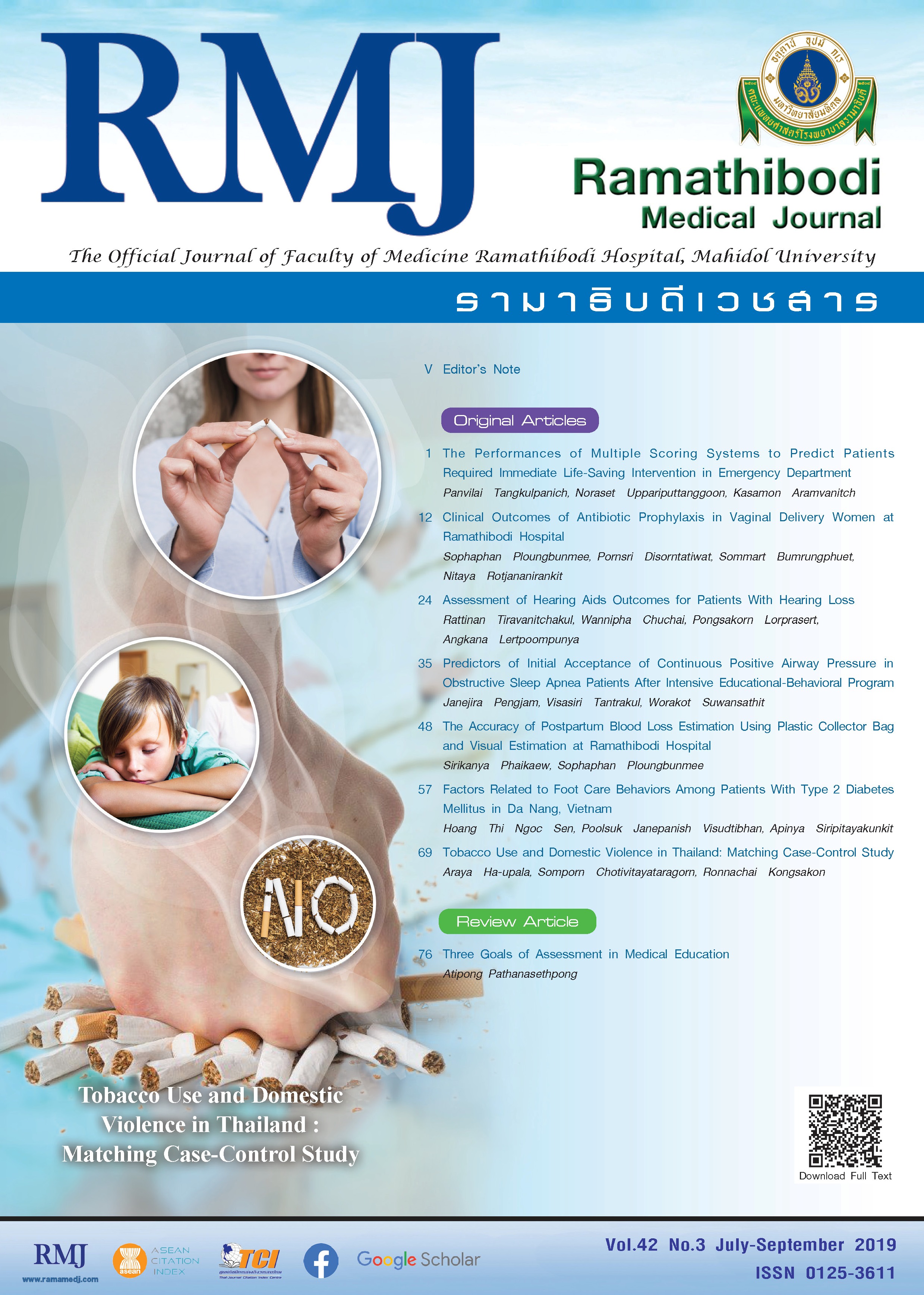Tobacco Use and Domestic Violence in Thailand: Matching Case-Control Study
DOI:
https://doi.org/10.33165/rmj.2019.42.3.165733Keywords:
Tobacco, Domestic violence, Thai society, Case-control studyAbstract
Background: Tobacco dependence is not only a major health risk which can be prevented, but also is a starting point to use other substances and domestic violence.
Objective: To study the association between tobacco use and domestic violence in Thai families.
Methods: The study was designed as a matched case-control study in women aged 15 years and over, living in households across the country, both in urban and rural areas, in 9 provinces of Thailand. The total of 600 participants were included in this study which half of them are from domestic abused families while the other half are from nonabused families. The criteria of age, education, economic status, housing area and region were determined. Differences between groups were performed using chi-square test and t test.
Results: Domestic violence families (55.7%) used tobacco as compared to 42% of families without violence who hadn’t used tobacco. The tobacco used families were significantly having more domestic violence 1.63 times (95% CI 1.17 - 2.29) than non-tobacco used families.
Conclusions: This study showed that tobacco used in the families were more likely to have domestic violence than non-used families. This could raise awareness on tobacco used to create campaigns to reduce the rate of tobacco used which causes domestic violence.
References
Webermann AR, Murphy CM. Childhood trauma and dissociative intimate partner violence. Violence Against Women. 2019:25(2):148-166. doi:10.1177/1077801218766628.
Kongsakon R, Pocham N. Domestic violence. Bangkok, Thailand: Sahaprchapanich; 2008.
Mahaphruetpaisan D, Charoenpunt P, Kongsakon R, Rattanarat N. Domestic violence in the industrial zone in Pathum Thani. Rama Med J. 2011;34(1):3-9.
Kongsakon R, Pocham N. Alcohol abuse and Domestic violence in Thailand: matching case-control study. J Psychiatr Assoc Thailand. 2007;52(3):296-305.
Teeraphan P. Domestic violence on Songkhla Lake Basin Area. Parichart Journal. 2016;29(2):155-168.
Chunsandee N, Wantrung S, Janthariwong S. Youth and domestic violence in Surin province. Graduate School Journal, Surindra Rajabhat University. 2014;8(1):100-109.
Ross R, Stidham A, Saenyakul P, Creswell J. Intimate partner violence, emotional support and health outcomes among Thai women: a mixed methods. Journal of the Royal Thai Army Nurse. 2015;16(1):22-32.
Jamal A, Phillips E, Gentzke AS, et al. Current cigarette smoking among adults - United States, 2016. MMWR Morb Mortal Wkly Rep. 2018;67(2):53-59. doi:10.15585/mmwr.mm6702a1.
Chotbenjamaporn P, Haruhansapong V, Jumriangrit P, Pitayarangsarit S, Agarwal N, Garg R. Tobacco use among Thai students: results from the 2015 global youth tobacco survey. Indian J Public Health. 2017;61(Supplement):S40-S46. doi:10.4103/ijph.IJPH_234_17.
Parker RA, Bregman DJ. Sample size for individually matched case-control studies. Biometrics. 1986;42(4):919-926.
Rosner B. Fundamentals of Biostatistics. 5th ed. Belmont, CA: Duxbury; 2000.
Aekplakorn W. Thai National Health Examination Survey, NHES V. Nonthaburi: Health System Research Institute; 2014.
Bosch J, Weaver TL, Arnold LD, Clark EM. The impact of intimate partner violence on women’s physical health: findings from the Missouri behavioral risk factor surveillance system. J Interpers Violence. 2017;32(22):3402-3419. doi:10.1177/0886260515599162.
Cheng D, Salimi S, Terplan M, Chisolm MS. Intimate partner violence and maternal cigarette smoking before and during pregnancy. Obstet Gynecol. 2015;125(2):356-362. doi:10.1097/AOG.0000000000000609.
Crane CA, Hawes SW, Weinberger AH. Intimate partner violence victimization and cigarette smoking: a meta-analytic review. Trauma Violence Abuse. 2013;14(4):305-315. doi:10.1177/1524838013495962.
Caleyachetty R, Echouffo-Tcheugui JB, Stephenson R, Muennig P. Intimate partner violence and current tobacco smoking in low- to middle-income countries: individual participant meta-analysis of 231,892 women of reproductive age. Glob Public Health. 2014;9(5):570-578. doi:10.1080/17441692.2014.905616.

















